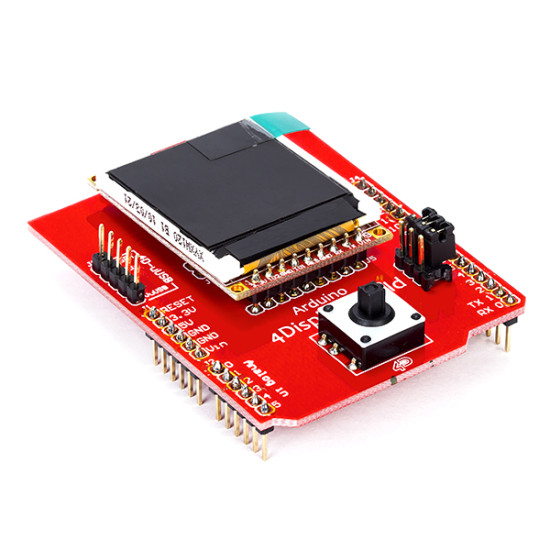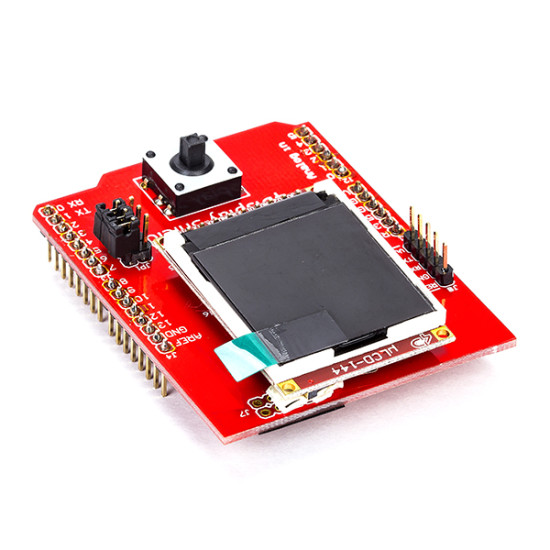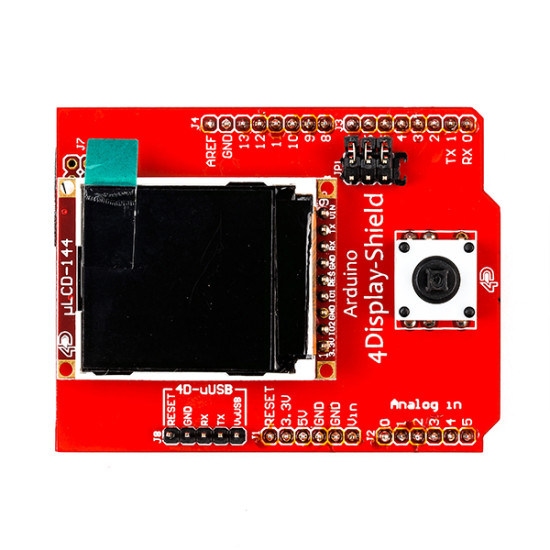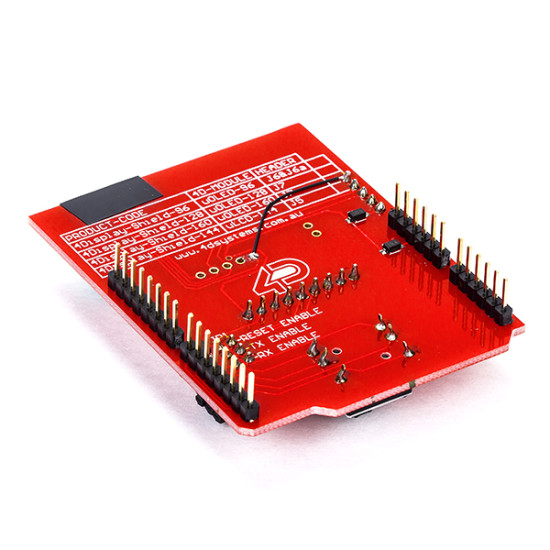







- Stock: Out Of Stock
- Brand: 4D Systems
- Model: ARD-1464
- Weight: 0.10kg
- MPN: 4Display-Shield-144
Description: The 4Display-Shield-144 provides an easy way of interfacing the popular uLCD-144 display module to the Arduino-Duemilanove, the Arduino-Mega and many other Arduino compatible boards. The unit comes complete with the uLCD-144 module, a 5 way multiswitch joystick and male headers that help connect the 4Display-Shield to the Arduino boards. The 5 position joystick is connected to the Arduino D2, D3, D4, D5 and D6 pins. The communication interface between the 4Display-Shield and the Arduino is via the Serial UART. Both the TX and RX signals are jumpered on the shield PCB so that the Arduino UART can be freed-up when it's being programmed.

The uLCD-144 module is integrated with a 1.44" full colour 128x128 pixel resolution LCD-TFT screen, tiny yet poweful GOLDELOX graphics controller chip and a micro-SD connector which supports standard and high-capacity memory cards. The memory card can be used to store images, icons, video clips and data logging.
Here is where it really gets interesting. The uLCD-144 module can be configured to run under 2 different operating modes or platforms:
- uLCD-144(SGC) : Serial Platform module
- uLCD-144(GFX) : 4DGL Platform module

Here are the differences between the (SGC) and the (GFX) platforms:
(SGC) Serial Platform:
The (SGC) Serial-Platform modules are based on the GOLDELOX-SGC Serial Graphics Controller chip. In this mode, the GOLDELOX-SGC (embedded in the uLCD-144) becomes the slave device and the Arduino takes the role of the host controller. This allows you to develop your graphics applications using the Arduino development environment and software tools. The GOLDELOX-SGC chip has a rich set of serial commands built inside the chip and the commands are sent from the Arduino via the serial (UART) interface. All it takes is a few bytes of serial data from the Arduino and you can quickly and easily draw lines, circles, text and even display Images as well as play Video clips.
All the resources for the SGC Serial-Platform are available under the "Serial Platform" downloads tab. We are currently developing serial command libraries for the Arduino but in the mean time the following links may prove useful.
* https://jennylc.com/4d/
* https://nicholasboka.com/?page_id=23
* https://code.google.com/p/arduino-oled/
(GFX) 4DGL Platform:
The (GFX) 4DGL-Platform modules are based on the GOLDELOX-GFX2 Graphics Controller chip. In this mode, the GOLDELOX-GFX2 (embedded in the uLCD-144) becomes a stand alone device and all application code is written in 4DGL (4D Graphics Language). Don't let the name scare you off, 4DGL is an easy to learn but a powerful high level language. It allows the developer to write applications in a high level syntax similar to popular languages such as BASIC, C and Pascal and run it directly on the GOLDELOX-GFX2 processor. If you can write Arduino code then you can certainly write 4DGL code. The (GFX) modules are stand alone devices. It allows the user to take complete control of all available resources on the uLCD-144 module such as the Serial Port, the graphics display and the micro-SD memory card. Thus graphics intensive processes can be completely offloaded from the Arduino and run on the GOLDELOX-GFX2 chip, along with micro-SD card processes and access to the GOLDELOX I/O pins. It provides the user complete control over the display module allowing them to offload a lot of overhead from the host processor by creating the 'work horse' objects within the display module itself.
So, for a game of Tetris, rather than sending all the tetris graphics objects (tile blocks, borders, game score, etc etc), as serial graphics primitives, entire functions can be created in 4DGL and receive simple serial commands to control them. This also gives a neat division between the graphics functions and the game itself, allowing changes in the games appearance without altering the main Arduino game code, effectively allowing you to 'change skins' for the games appearance.
All the resources for the GFX 4DGL-Platform are available under the "4DGL Platform" downloads tab.
NOTE: There is only a single GOLDELOX chip in the uLCD-144 module. The chip can be configured to be either a GOLDELOX-SGC or a GOLDELOX-GFX2 by programming the appropriate PmmC configuration file (Personality module micro Code) in to the chip. Think of it as a soft silicon where the silicon can be reconfigured via the PmmC file. There is a 5 pin male program header available on the 4Display-Shield to program the GOLDELOX with PmmC files as well as to download 4DGL application code when the chip is configured as the GOLDELOX-GFX2.
Features
- 128 x 128 resolution, 65K true to life colours, LCD-TFT screen.
- 1.44” diagonal size, Viewing Area: 25.5mm x 26.5mm.
- No back lighting with near 180° viewing angle.
- On-board micro-SD memory card adaptor for storing of icons, images, animations, etc. Supports standard and high capacity (HC-SD) memory cards.
- 5-Way multifunction Joystick switch directly connected to Arduino D2, D3, D4, D5 and D6 pins.
- Powered from the Arduino board, uses the 5V supply pin.
- RoHS Compliant.
Package Includes:
- 1 x 1.44" LCD Display Shield for Arduino
Documents & Downloads:
Note: The price mentioned is only for display Shield , it does not include Arduino Board.









